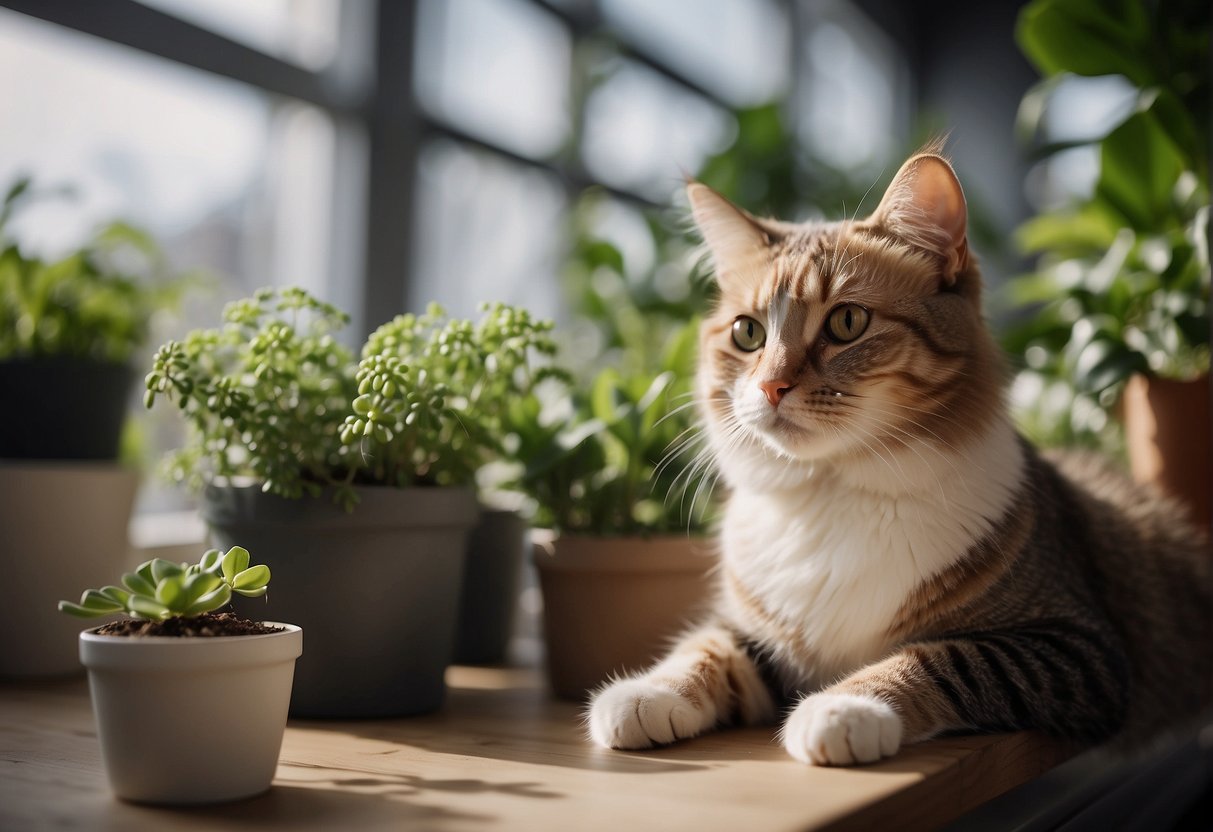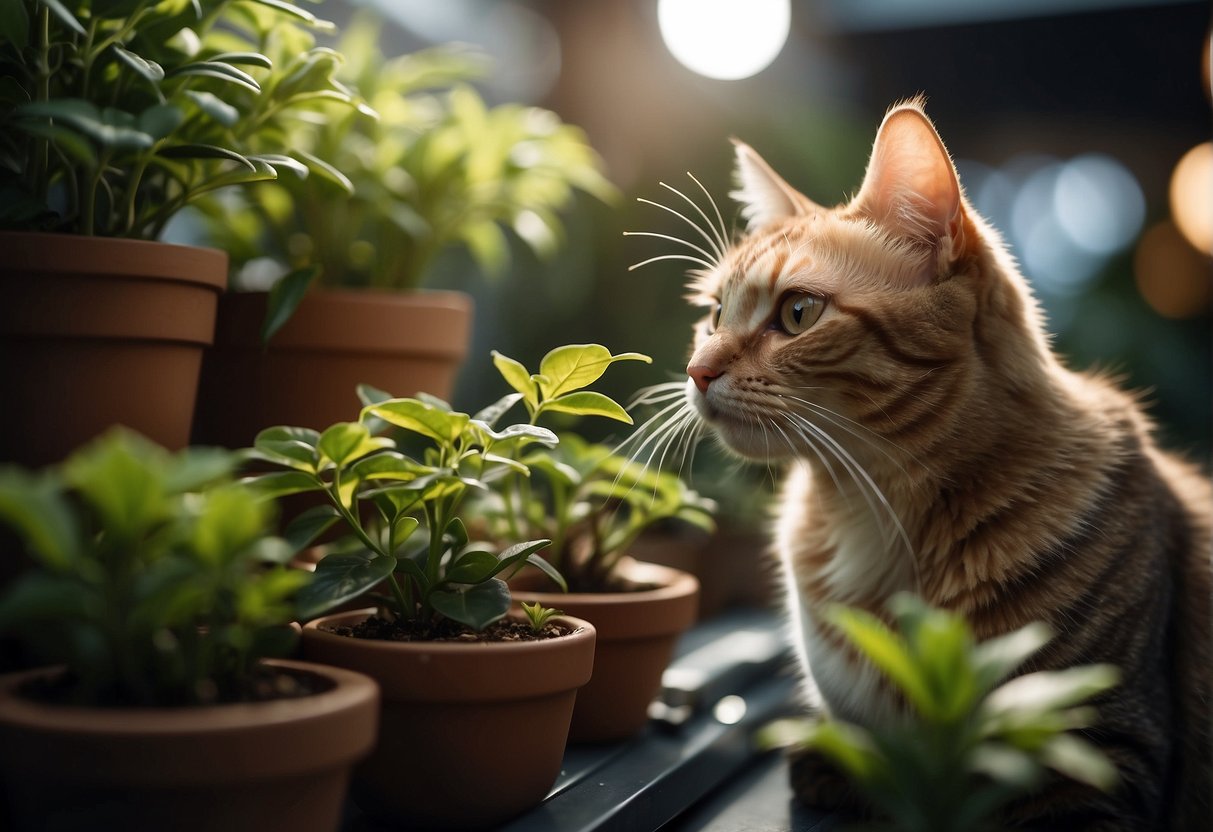Cat-proofing indoor plants is essential to ensure the safety of your feline friends and the survival of your greenery. If you’ve ever found your cat chomping on your favorite houseplant or using the pot as a litter box, you know the struggle is real. To tackle this, many cat owners, myself included, have had success with a few strategic tactics.
For instance, spreading a bit of orange peel around the base of the plant or lightly misting the leaves with diluted citrus can naturally deter cats, as their noses are sensitive to these scents.

Cats are curious creatures by nature and often find plants an intriguing part of their indoor jungle. To maintain harmony in your home, it’s beneficial to use harmless deterrents.
Some find that creating a separate space for the cat to enjoy, away from precious houseplants, can reduce the allure of those forbidden greens. Others have had success with certain safe sprays like a mild vinegar solution or by placing physical barriers like decorative rocks on top of the soil.
Keeping your cat entertained with their own toys and cat grass can also redirect their attention from your plants. Remember, cat-proofing is about providing alternatives and deterrents while ensuring any methods you choose are safe for your pet.
The goal is simple: to cultivate a living space where both your plants and your beloved pets can thrive, away from unnecessary nibbles and damage.
Cats And Their Obsessions With Plants

When it comes to cat-proofing your plants, it’s important to appreciate why your feline friends might be drawn to your greenery in the first place. Your cat’s natural instincts and the environment you create for them play crucial roles in guiding their behavior with household plants.
Natural Instincts and Plant Interaction
Cats have an innate curiosity that drives them to explore their environment, and this includes the plants in your home. They may nibble on leaves or paw at soil for a variety of reasons:
- Curiosity: Cats explore the world with their senses, and a plant’s movement or texture can be intriguing.
- Hunting Simulation: Swatting at dangling leaves might mimic hunting behaviors, fulfilling an instinctive need.
- Health: Sometimes, cats will chew on plants to aid in digestion or to help bring up hairballs.
To redirect this natural behavior, provide cat-friendly alternatives such as:
- Cat Grass: Grow cat grass in a pot for a safe nibbling option.
- Catnip: Use catnip to draw your cat away from other plants.
Creating a Cat-Friendly Environment
Creating an inviting space for your cat that fulfills their instinctual needs can minimize their interest in your plants. Consider these strategies:
- Distraction: Invest in cat toys or a scratching post to provide an outlet for their energy.
- Cat-Friendly Plants: Introduce plants that are safe for cats to interact with, like spider plants or valerian.
- Positive Reinforcement: When your cat chooses their toys over your plants, reward them to reinforce the behavior.
Safe Plants and Dangerous Plants
As a cat owner, ensuring the safety of your pets while keeping your home green can be challenging. Knowing which plants are safe and which pose risks is crucial. Let’s take a look at both non-toxic and toxic plants for your feline friends.
Non-Toxic Plants for Cats
Here are some safe plants that you can consider for your home:
- Spider Plant: A resilient plant that’s excellent for hanging baskets.
- Boston Fern: These lush ferns are great for a pop of green and safe for your cats.
- Bamboo Palm: A beautiful indoor addition and completely safe for feline nibbles.
Pro Tip: Always check a comprehensive list or consult your vet when in doubt about plant safety.
Common Toxic Plants for Cats
Be aware of these common plants that are dangerous to cats, some of which may surprise you:
- Lilies (Lilium spp.): Extremely dangerous, can cause kidney failure even in small amounts.
- Sago Palm: Even a few seeds can be lethal as they contain cycasin.
- Daffodil: The bulbs are toxic, causing vomiting, salvation, or worse if ingested.
- Dieffenbachia: Can cause oral irritation and digestive upset.
- Tulips: The bulbs contain allergenic lactones which are very toxic to cats.
Remember, this is just a shortlist, always research individual plants before bringing them into your home where your cat can access them.
Physical Barriers and Deterrents
Creating a safe and harmonious space for both your plants and your feline friend often involves using deterrents and barriers. Carefully chosen and strategically placed, these can protect your plants while remaining cat-friendly.
Homemade and Commercial Repellents
Homemade Repellents:
- Mix citrus peelings or lemon juice with water for a natural spray that cats typically avoid due to their aversion to citrus scents.
- A solution of vinegar and water can act as a deterrent when sprayed around plants, as most cats dislike the smell of vinegar.
Commercial Repellents:
- Opt for products labeled as commercial cat repellent, which are designed to keep cats at bay without harming them.
- Be sure to follow the manufacturer’s instructions for application to ensure effectiveness and safety for your pet.
Utilizing Natural Deterrents
Plant Choices:
- Cats generally steer clear of certain aromatic plants like rosemary because of their strong scent.
- Sprinkle cayenne pepper near your plants; it’s a powerful natural deterrent due to its spicy nature.
Essentials Oils:
- Use oils like citrus or rosemary on cotton balls and place them around the plants. Ensure they are out of reach, as essential oils can be harmful to cats if ingested.
Protective Coverings and Obstacles
Mesh and Covers:
- Use mesh netting to cover plants, which prevents cats from accessing the soil while allowing light and water to penetrate.
- Placing aluminum foil around the base of the plant can discourage digging as cats dislike the texture.
Barrier Methods:
- Arrange physical barriers such as pinecones or decorative rocks on top of the soil to make it less inviting for cats to dig.
- Install small bamboo spikes or forks in the soil, ensuring they are not sharp enough to harm your cat but serve as a gentle reminder to stay away.
Alternative Solutions and Preventive Measures
Creating a safe and engaging environment for both your plants and your feline friend often requires a bit of creativity and strategic planning. The aim here is to find harmony between your cat’s natural behaviors and the well-being of your indoor greenery.
Designated Plant Rooms and Cat-Free Zones
One effective strategy is to establish designated plant rooms or specific areas as cat-free zones. This can be achieved by using baby gates or screened doors to prevent access.
By doing so, you protect your plants without causing distress to your cat. Ensure these areas are well-ventilated and have ample sunlight for your plants to thrive.
Distracting Cats with Alternatives
Cats are curious by nature, so it’s beneficial to offer them enticing alternatives that will deter them from your plants. Consider these two:
- Catnip and Cat Grass: Plant cat-friendly greens like catnip or cat grass in areas where your cat can indulge freely. These provide a healthy outlet for their grazing habits.
- Cat Deterrent Spray: Use commercially available or homemade cat deterrent sprays that contain scents cats dislike, such as citrus or vinegar, to create a natural barrier around your plants.

My name is James, and welcome to FAQCats!
Along with our team of cat owners, expert pet enthusiasts, and pet professionals, we aim to write engaging helpful, engaging content about cats. At FAQCats we strive to provide content that’s accurate and fun to read. Our team writes about everything related to cats; even the most complex of topics. Through extensive research and caring for our own fur-pals, we’re able to provide something cat owners worldwide will love. Have a look around, and leave us feedback anytime!

